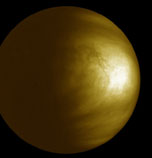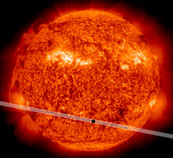
|
Astronaut
An astronaut is a person traveling, working and living in space.
The Space Shuttle and the International Space Station are two places that
have many astronauts from all over the world working together. Astronauts
are busy with scientific experiments to find out how our universe works. It
takes a lot of training to be an astronaut and usually, you go to school
for quite a while. You need to be good at science, math, using computers and navigation.
|

|
Aurora
Auroras are bright, colorful lights we see in the northern and southern night sky.
The lights are formed by the interaction of solar wind particles with the Earth's
magnetosphere exciting gas molecules in the air. The light from an aurora moves
like a large, flowing curtain. Most often we see auroras close to Earth's North
and South Poles. Sometimes, if the conditions are right, auroras can be seen nearer
the Earth's equator. Auroras have been seen as in places like Florida
and Argentina-and even in Hawaii! The atoms in Earth's atmosphere glow in different
colors. Oxygen and nitrogen glowing in the upper atmosphere cause red and green
auroras. Nitrogen can also cause auroras with a violet-purple color.
|
|

|
Corona
The corona is the Sun's outer atmosphere. During a total solar eclipse, we
can see the Sun's corona. Scientists use a tool called a chronograph to
study the corona and other things very close to the Sun.
The coronagraph blocks the Sun's bright surface, so that the corona becomes
visible. The corona is very, very hot—more than a million degrees F. Scientists
are still trying to figure out why the corona is hotter than other parts
of the Sun. This is a big mystery.
|
|

|
Coronal Mass Ejections
Coronal mass ejections are big eruptions from the Sun. The particles shoot out from
the surface of the Sun. Sometimes, but not very often, they head toward Earth and
can cause lights to go out and cell phones to stop working. Scientists call
a coronal mass ejection a CME. Scientists study the Sun in the hope of
predicting when a CME will come toward Earth and make sure that our satellites are not harmed.
|

|
Convection Zone
The Sun has several layers or zones. One of them is called the convection zone.
Convection is how energy moves from the inner parts of the Sun to the outer part
of the Sun that we see. We can see convection on Earth when we look at a pot
boiling away on the stove. (Stay away from the stove—it's hot!)
Convection is what makes the bubbles form in a pot of boiling soup.
Through convection the heat moves up from the bottom of the hot pot
to the soup's surface where it is cooler and then back down again where it
is hotter. This same process is happening on the Sun.
|

|
Cycle
A cycle is something that happens over and over, like day and night. A year here
on Earth is also a cycle. Many things in the universe happen in cycles.
Think about all the planets orbiting the Sun over and over again. Think
about comets which fly by Earth on a regular cycle. Even your birthday is on a cycle-it
happens every year on the same day! In other words, a cycle is a repeating pattern.
|

|
Magnetosphere
The magnetosphere is an invisible, magnetic shield around Earth that protects us
from the solar wind. Generally the magnetosphere does a very good job of keeping
the solar wind away from us. But, when the Sun is very active the solar wind
can change the shape of the magnetosphere and our magnetosphere can get a bit squashed.
|
|
|
Photon
A small packet of light energy. Photons flow out of the Sun.
|

|
Photosphere
The photosphere is the part of the Sun that we can see. We also call the photosphere
the Sun's surface. But the Sun is not solid-it is a giant ball of hot gases.
Sunspots indicate giant magnetic storms and they are visible in the Sun's photosphere.
Most of the time sunspots come in pairs-like the poles of a magnet. Even though sunspots
are very, very hot they look darker than the rest of the Sun because they're cooler.
Remember, NEVER look directly at the Sun. You can permanently damage your eyes.
|

|
Plasma
Plasma is a fourth state of matter made up of positively charged protons and negatively charged electrons.
|

|
Satellite
A satellite is a free-flying object that orbits Earth or another body in space.
There are many satellites around the Earth. Satellites send us information about
Earth, the Sun and space. Some satellites help make our televisions and cell phones
work! When there is a lot of solar activity scientists try to make sure that satellites
are protected from solar storms. When you think about it, our Moon is a satellite too,
because it orbits Earth.
|

|
Solar Maximum
Solar maximum is the time when the Sun is the most active. Every 11 years the Sun becomes
very, very active. Solar flares erupt almost every day, coronal mass ejections
sweep off the Sun, lots of big sunspots can be seen and the Sun experiences many magnetic
storms.
|

|
Solar Minimum
Solar minimum is the time when the Sun is not very active. During solar minimum,
we see fewer solar storms, flares and sunspots. The Sun is on a cycle-every 11 years it
becomes active, then it becomes quiet. This solar cycle happens over and over again.
|

|
Solar Wind
The solar wind is always flowing from the Sun. The Sun doesn't just send us light,
but it also sends tiny particles to Earth. These particles, or plasma, are moving very,
very fast. The solar wind travels past Earth at more than a million miles per hour.
Because we are protected by the magnetosphere, the solar wind usually flows around Earth.
But the Sun is dynamic-that means it changes. (See the "Solar Maximum" and "Solar Minimum"
sections.) Sometimes the Sun and the solar wind get very active. We can see beautiful
auroras. But we need to be careful too. When the solar wind is really powerful,
we can lose power, our radios and televisions can get poor reception and satellites
and spacecraft can be damaged. In 1989 parts of Canada and the United States lost
all their power and the lights went dark for more than 9 hours because of a powerful
solar storm.
|

|
Star
A star is an object that makes energy. It gives off light and heat. Stars are glowing
balls of very hot gases. We may think of stars as shining only at night, but that
is not true. We have our very own star that we see every day: the Sun.
The Sun is our closest star and it is always shining somewhere on Earth!
|

|
Sunspot
A sunspot is a spot on the Sun that is darker and cooler than the rest of the Sun.
Sunspots are very large magnetic storms on the surface of the Sun. Sunspots often
come in pairs like the North and South Poles on Earth or the poles on a bar magnet.
They look darker because they are cooler than the rest of the Sun—but they are still
extremely hot. Sunspots can be very, very large. Some sunspots are as large as Earth.
|

|
Venus
Venus is one of the nine planets in our solar system. It is the second planet
from the Sun. (Remember, we are the third planet so Earth and Venus are sort of
like distant neighbors.) Venus is only a little smaller than Earth. It is covered
with clouds, but the clouds are not like Earth’s clouds. We could not breathe on
Venus. A lot of Venus is covered with lava and it has volcanoes. Unlike Earth,
Venus is very, very hot and dry. Scientists think that a long, long time ago,
Venus probably had lots of water like we do on Earth, but it all boiled away.
Venus does not have a magnetosphere (a special, invisible, magnetic shield) to
protect it from the solar wind. You can see Venus in the early evening or early
morning. It is a very bright planet. On June 8th, 2004 something exciting is
happening and with some special equipment, you will be able to see Venus and the Sun!
|

|
Venus Transit
June 8th, 2004 is a very special day-it is the Transit of Venus! A transit of
Venus does not happen very often. The last time it happened was in 1882 and
there will not be another one until 2012. On June 8th, Venus will be between Earth
and the Sun. From Earth we will be able to see Venus in its orbit around
the Sun. Using special telescopes we will be able to watch Venus move slowly
across the face of the Sun! It will be very exciting! The Transit of Venus
is important because it first allowed astronomers to calculate the distance
between Earth and the Sun (93 million miles!). Astronomers call this distance
the "Astronomical Unit" or "AU." They use it to measure the huge distances
we have in our universe. Having the AU makes astronomers' work easier and more accurate.
|

